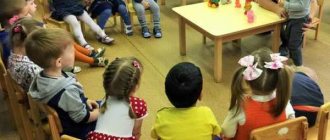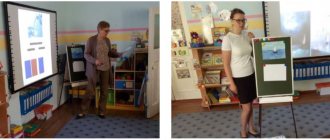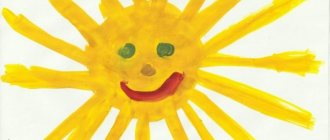A small child, one way or another, is a tireless researcher who is interested in knowing absolutely everything. He pokes his nose everywhere and constantly asks his parents questions about the origin of this or that phenomenon or object. The knowledge he will have depends on how many different and exciting things a preschooler sees.
If a toddler does not observe and does not know anything except his home, his thinking will be quite narrow. With the help of cognitive development according to the Federal State Educational Standard, the child begins to immerse himself in independent activities, develops his imagination and curiosity.
Lesson on cognitive development in the middle group
The importance of cognitive development of children in the middle group of preschool educational institutions
In government preschool institutions, everything is created to ensure that children have the opportunity to satisfy their curiosity. In order for the development of the cognitive sphere to be effective, it is necessary to organize special events.
Note! Activity in any of its manifestations is an important component for the harmonious development of preschool children. Indeed, in cognitive activity, children study the world around them, interact with various objects and acquire specific skills.
Cognitive development in the middle group of kindergarten expands ideas about the environment and enriches vocabulary. Experienced teachers recommend conducting classes in a natural corner, a music area, or a place for playing on the floor. All the necessary attributes are placed using the mosaic method so that children do not interfere with each other while playing.
The main goals and objectives of cognitive development in children 4-5 years old
The main tasks of cognitive activity are to encourage curiosity, identify the baby’s interests, formulate actions that are aimed at understanding the world around him, and develop creative inclinations. In addition, the main goals include the following:
- formation of knowledge about oneself as an individual;
- familiarization with concepts such as color, shape, volume and quantity;
- children study their homeland, get acquainted with the cultural values and customs of their country.
In addition, the little ones gradually learn that the animal and plant world can be diverse, since during classes they work with local specimens.
Formation of mathematical concepts in children
Mathematical knowledge plays an important role in the development of a child, because with the help of various techniques, children develop pre-numerical and numerical ideas and knowledge about the shapes, sizes and locations of objects in space. And this, in turn, is necessary to ensure general developmental orientation, training, and connection with mental and speech development.
Cognitive research activities and sensory development
The emergence of cognitive-research activity occurs at an early age on the basis of subject-manipulative cognition. It is a simple and “purposeless” experimentation with things, during which the categorization of objects by color, shape, and purpose appears. The development of sensory standards and simple instrumental actions also occurs.
Sensory development in the garden
As for sensory education, with its help the child learns the standard external properties of objects: their color, size, as well as aroma and taste. The age of 4-5 years is most suitable for improving the senses of touch and accumulating ideas about the world around us.
Getting to know the world of objects
At 4-5 years of age, the child develops ideas about objects and natural phenomena that the toddler often encounters. During object-sensory education in classes or in play, the preschooler observes, identifies and identifies individual signs of vegetables, plants and domestic animals, and also learns to distinguish between the signs of winter, spring, autumn and summer.
Drawing classes for children 2-3 years old - teaching the baby
Important! With the help of such sensory standards as color, shape and size, kids compare phenomena and objects and combine them into groups according to external characteristics.
Introduction to society
Child psychologists and teachers argue that the priority direction for getting to know society is to form the foundations of a person’s basic culture, prepare a preschooler for life in modern society and develop creative potential. To interact with the family and society, teachers should arrange excursions to objects located outside the kindergarten territory as often as possible.
Introduction to the natural world and environmental education
The environmental education of children in the middle group of preschool educational institutions has an important social significance for the whole society. It is extremely important that the foundations of ecological culture in the human personality are laid in a timely manner.
The teacher should tell the kids how animals will spend the winter in the forest, and direct the children’s active activities so that they consciously preserve nature (pets, birds), have environmental knowledge and have a moral attitude towards the world and space. It would also be a good idea to study all the months (January, February, March, etc.) with preschoolers.
WORK PROGRAM in the educational field “Cognitive development”
Order of the Ministry of Education and Science of the Russian Federation dated August 30, 2013 No. 1014 “On approval of the Procedure for organizing and implementing educational activities in basic general education programs - educational programs of preschool education” (Registered with the Ministry of Justice of Russia on September 26, 2013 No. 30038);
Charter of the Municipal Budgetary Preschool Educational Institution “Kindergarten “Sandugach”, Shygyrdan village, Batyrevsky district.
1.2.
The purpose of the work program is
to develop children's interests, curiosity and cognitive motivation; creative activity.
1.3. Tasks of the work program:
1. Formation of cognitive actions, formation of consciousness.
2. Formation of primary ideas about oneself, other people, objects of the surrounding world, about the properties and relationships of objects of the surrounding world (shape, color, size, material, sound, rhythm, tempo, quantity, number, part and whole, space and time, movement and rest, causes and effects, etc.).
3. Formation of ideas about planet Earth as the common home of people, about the peculiarities of its nature, the diversity of countries and peoples of the world.
4. Formation of knowledge about the small homeland and Fatherland, ideas about the socio-cultural values of our people, about domestic traditions and holidays.
5. Formation of a conscious attitude towards compliance with traffic rules.
1.4.
Principles and approaches to the formation of a work program
When constructing a work program, the following principles are taken into account:
Corresponds to the principle of developmental education, the goal of which is the development of the child;
Combines the principles of scientific validity and practical applicability (the content of the work program must correspond to the basic principles of developmental psychology and preschool pedagogy)
Meets the criteria of completeness, necessity and sufficiency (allow you to solve set goals and objectives only using necessary and sufficient material, get as close as possible to a reasonable “minimum”);
Ensures the unity of educational, developmental and training goals and objectives of the education process for preschool children, in the process of implementation of which such knowledge, skills and abilities are formed that are directly related to the development of preschool children;
It is built taking into account the principle of integration of educational areas in accordance with the age capabilities and characteristics of students, the specifics and capabilities of educational areas;
Based on the complex thematic principle of constructing the educational process;
Provides for the solution of program educational tasks in the joint activities of adults and children and independent activities of children, not only within the framework of direct educational activities, but also during routine moments in accordance with the specifics of preschool education;
What types of activities help cognitive development?
Today in pedagogy there are many techniques that are used during classes in kindergarten. The main methodological types of familiarization with the environment include:
- stories;
- reading fairy tales and other works of fiction;
- conversations and explanations.
In addition, many teachers today resort to commented drawing and modeling, which allows children to see in a simple form what is being discussed. In the process of planning and conducting this type of activity, the teacher must become a magician who makes objects move and transform.
Forms of working with children on cognitive development
Note! Modeling and annotated drawing are similar to animation, when pictures on paper or a monitor appear gradually, but are interconnected by a storyline and logical conclusion.
Organization of educational activities for cognitive development in the middle group according to the Federal State Educational Standard
The purpose of organizing cognitive and research activities in kindergarten according to the Federal State Educational Standard is to develop preschoolers' research skills and the ability to independently search for the necessary information. The teacher must come and awaken in the children the motivation and desire to find answers to questions of interest, as well as encourage curiosity.
For research education, you can use both independent and group classes, accompanied by play activities. If a child knows how to pose a question in connection with the occurrence of an unknown object or phenomenon, and then finds the answer, this indicates his high level of mental and mental development.
Didactic games on cognitive development in the middle group (card index)
Popular cognitive education games include “What’s for whom,” “Where can I buy it,” and “What’s it made of.” In the process of conducting “What to Whom,” students must name the profession in accordance with the subjects of work, and also remember where they could see such a worker.
Drawing lesson in the second junior group on the topic “Planes are flying”
To do this, you need to lay out toy tools of people of different professions on the table. The didactic objectives of such a game are as follows:
- nurturing interest in the work activities of adults;
- the desire to help their parents, to try on the roles of people of different professions in a playful way.
During the “Where can I buy it” lesson, students match items with the names of stores on paper cards (the principle of the game is similar to lotto). Preschoolers are given pictures, after which each of them must say in which store they can buy it and put the image on a large card.
Note! The didactic objectives of the game “What is it made of” are to teach children to combine objects according to the material (clothing, transport) from which they are made, to activate the entire vocabulary, to develop observation skills and the ability to clearly follow the rules of the game.
Before playing the game, the teacher should talk to the children and clarify whether they know that all objects are made of different materials. After this, the kids need to determine by touch what this or that object is made of and tell a little about it.
Templates for the game “What is it made of”
Card file on cognitive development for middle group children
Red.
Children take turns answering: berry, ball, flag, star, car, etc.
— Round (ball, sun, apple, wheel, etc.)
44. Didactic game “What can animals do?”
Target:
learn to create a wide variety of word combinations; expand the semantic content of the word in the mind; develop memory.
Progress of the game
: Children turn into “animals”. Everyone must tell what they can do, what they eat, how they move. The one who tells the story correctly receives a picture of an animal.
I'm a red squirrel. I jump from branch to branch. I make provisions for the winter: I collect nuts and dry mushrooms.
I am a dog, cat, bear, fish, etc.
45. Didactic game “Come up with another word”
Target:
Expand words knowledge; develop attention.
Progress of the game
: The teacher says “Come up with another, similar word from one word. You can say: a milk bottle, or you can say a milk bottle.” Cranberry jelly (cranberry jelly); vegetable soup (vegetable soup); mashed potatoes (mashed potatoes).
46. Didactic game “Choose similar words”
Target:
teach children to clearly pronounce polysyllabic words loudly; develop memory and attention.
Progress of the game
: The teacher pronounces words that sound similar: spoon - cat, ears - guns. Then he pronounces one word and invites the children to choose others that are similar in sound: spoon (cat, leg, window), cannon (fly, dryer, cuckoo), bunny (boy, finger), etc.
47. Didactic game “Who will remember more?”
Target:
enrich children's vocabulary with verbs denoting the actions of objects; develop memory, speech.
Progress of the game:
Carlson asks them to look at the pictures and tell them what they do and what else they can do.
A blizzard is sweeping, blizzarding, blizzarding.
The rain is pouring, drizzling, drizzling, dripping, starting, lashing, ...
Crow—flies, croaks, sits, eats, perches, drinks, howls, etc.
48. Didactic game “What else do they talk about?”
Target:
consolidate and clarify the meaning of polysemantic words; cultivate a sensitive attitude to the compatibility of words in meaning, develop speech.
Progress of the game
: Tell Carlson what else you can say this about:
It's raining: it's snowing, winter, boy, dog, smoke.
Plays - girl, radio, ...
Bitter - pepper, medicine, .. etc.
49. Didactic game “Invent it yourself”
Target
: teach to see in various objects possible substitutes for other objects suitable for a particular game; develop the ability to use the same object as a substitute for other objects and vice versa; develop speech and imagination.
Progress of the game
: The teacher invites each child to choose one object (a cube, a cone, a leaf, a pebble, a strip of paper, a lid) and to fantasize: “How can you play with these objects?” Each child names the object, what it looks like and how you can play with it.




